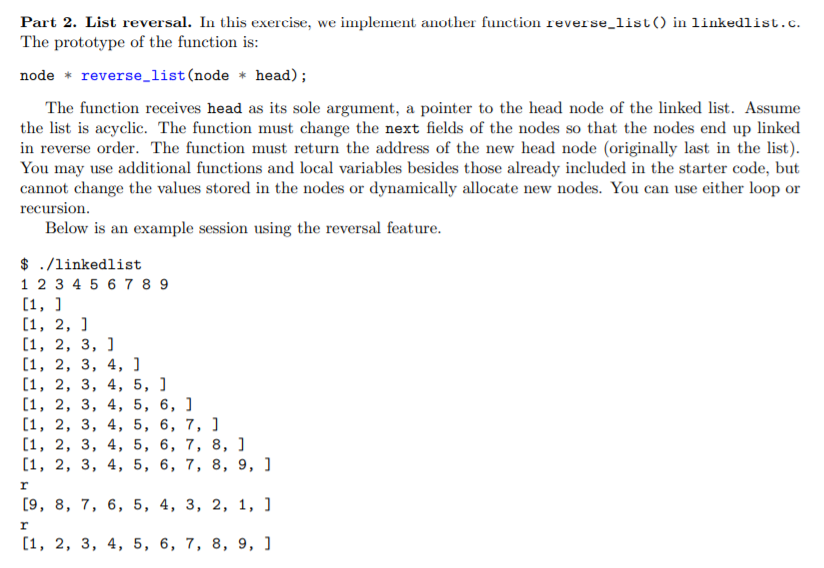Question
Implement the bolded prototype reversal function of the given c source code #include #include #include #include /***** error message *****/ enum ErrorNumber {ERR_OK, ERR_NOMEM, ERR_NODELETE,

Implement the bolded prototype reversal function of the given c source code
#include
/***** error message *****/ enum ErrorNumber {ERR_OK, ERR_NOMEM, ERR_NODELETE, ERR_NOTFOUND, ERR_NOSORT, ERR_NOREVERSE, ERR_LONGTOKEN, ERR_NONUMBER, ERR_UNKNOWNTOEKN, ERR_END};
// print an error message by an error number, and return // the function does not exit from the program // the function does not return a value void error_message(enum ErrorNumber errno) { char *messages[] = {"OK", "Memory allocaton failed.", "Deleting a node is not supported.", "The number is not on the list.", "Sorting is not supported.", "Reversing is not supported.", "Token is too long.", "A number should be specified after character d, a, or p.", "Token is not recognized.", "Invalid error number."};
if (errno ERR_END) errno = ERR_END; printf("linkedlist: %s ", messages[errno]); }
/***** list *****/ typedef struct node_tag { int v; struct node_tag * next; // A pointer to this type of struct } node; // Define a type. Easier to use.
node * new_node(int v) { node *p = malloc(sizeof(node)); // Allocate memory if (p == NULL) { error_message(ERR_NOMEM); exit(-1); }
// Set the value in the node. p->v = v; // you could do (*p).v p->next = NULL; return p; // return }
node * prepend(node * head, node * newnode) { newnode->next = head; return newnode; }
node * find_node(node * head, int v) { while (head != NULL) { if (head->v == v) return head; head = head->next; } return head; }
node * find_last(node * head) { if (head != NULL) { while (head->next != NULL) head = head->next; } return head; }
node * append(node * head, node * newnode) { node *p = find_last(head);
newnode->next = NULL; if (p == NULL) return newnode; p->next = newnode; return head; }
node * delete_list(node * head) { while (head != NULL) { node *p = head->next; free(head); head = p; } return head; }
void print_list(node *head) { printf("["); while (head) { printf("%d, ", head->v); head = head->next; } printf("] "); }
void print_node(node * p) { printf("%p: v=%-5d next=%p ", p, p->v, p->next); }
void print_list_details(node *head) { while (head) { print_node(head); head = head->next; } }
// functions that have not been implemented
node * delete_node(node * head, int v) { // TODO error_message(ERR_NODELETE); return head; }
/* * Given a pointer to the head node of an acyclic list, change the * next links such that the nodes are linked in reverse order. * Allocating new nodes or copying values from one node to another * is not allowed, but you may use additional pointer variables. * Return value is a pointer to the new head node. */ node * reverse_list (node * head) { // TODO error_message(ERR_NOREVERSE); return head; }
/***** main *****/
// Make sure the numbers match in the following two macros #define MAX_TOKEN_LEN 32 #define FORMAT_STR "%32s"
void print_help(void);
int main(int argc, char **argv) { int res; char token[MAX_TOKEN_LEN + 1]; // add 1 for NUL
node *head = NULL;
while (1) { res = scanf(FORMAT_STR, token); if (res == EOF) break; if (! isspace(getchar())) { error_message(ERR_LONGTOKEN); exit(-1); } // puts(token);
if (!strcmp(token, "help")) { print_help(); continue; } else if (!strcmp(token, "reverse") || !strcmp(token, "r")) { head = reverse_list (head); } else if (!strcmp(token, "info") || !strcmp(token, "i")) { printf("head = %p ", head); print_list_details(head); } // could support more functions/commands else { // try to convert it to an integer // we use atol() long lv; char *endptr;
char action = 'a'; char *pn = token;
if (token[0] == 'd' || token[0] == 'a' || token[0] == 'p') { if (! token[1]) { error_message(ERR_NONUMBER); continue; }
action = token[0]; pn ++; }
lv = strtol(pn, &endptr, 10); // decimal numbers if (*endptr) { // the entire token should be a valid number error_message(ERR_UNKNOWNTOEKN); printf("%s ", token); continue; }
int i = lv;
switch (action) { case 'd': head = delete_node(head, i); break; case 'a': case 'p': { node *p; p = find_node(head, i); if (p != NULL) { print_node(p); } else { p = new_node(i); head = (action == 'p') ? prepend(head, p) : append(head, p); } break; } default: // should not be here. break; } } print_list(head); } head = delete_list(head); return 0; }
void print_help(void) { // Example of long strings char * helpmsg = "a
Step by Step Solution
There are 3 Steps involved in it
Step: 1

Get Instant Access to Expert-Tailored Solutions
See step-by-step solutions with expert insights and AI powered tools for academic success
Step: 2

Step: 3

Ace Your Homework with AI
Get the answers you need in no time with our AI-driven, step-by-step assistance
Get Started


